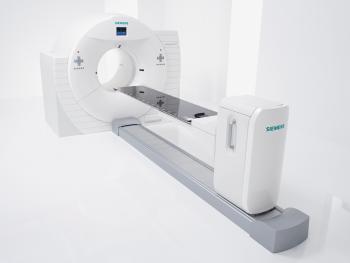
Photo: Biograph mCT PET/CT system
A little more than a year ago, a marriage of sorts shook up the world of radiation therapy. Varian Medical Systems and Siemens Healthcare formed a partnership to provide advanced diagnostic and therapeutic solutions and services for treating cancer with image-guided radiotherapy and radiosurgery.

Photo: Biograph mCT PET/CT system
A little more than a year ago, a marriage of sorts shook up the world of radiation therapy. Varian Medical Systems and Siemens Healthcare formed a partnership to provide advanced diagnostic and therapeutic solutions and services for treating cancer with image-guided radiotherapy and radiosurgery.
The collaboration covered the mutual marketing and representation of products for imaging and treatment in the global radiation oncology business. This collaboration included the development of software interfaces between Siemens and Varian treatment systems. The two companies also agreed to pursue opportunities for joint development of new products for image-guided radiotherapy and radiosurgery.
Under the agreement, Varian represents Siemens diagnostic imaging products such as CT, PET/CT or MRI to radiation oncology clinics around the world. Siemens Healthcare represents Varian equipment and software for radiotherapy and radiosurgery within its offerings to its healthcare customers. The goal was to enable the companies to offer comprehensive solutions to support the entire clinical workflow from imaging to treatment.
By all accounts, the marriage is “a match made in heaven,” said Mike Rittman, director of marketing for Siemens Medical Solutions USA. I stopped to chat with Mike at the 2013 annual meeting of the Society of Nuclear Medicine and Molecular Imaging (SNMMI) at the Vancouver Convention Center in beautiful British Columbia.
“Siemens used to make our own linear accelerators and proton therapy devices and we decided to exit that part of the business and reposition ourselves as the imaging partner of choice,” said Rittman. “Varian was the market share leader in radiation therapy. They’ve developed technologies that have the finest precision in treating tumors. But the best linear accelerator is only as good as the images that guide the therapy. They needed an imaging partner to leverage those technologies.”
Rittman started drawing on some paper to illustrate how PET/CT imaging can pinpoint the areas of the tumor that are actually cancerous. He showed me how previously an entire lung tumor might be dosed. “But you can’t use a one-size-fits-all solution,” he explained. So when Varian developed an innovative way to shape a radiation beam, the new PET/CT imaging was able to show what was actually cancerous and what was just dead necrotic tissue. Siemens’ Biograph mCT now provides the best resolution to guide that beam.
“Now the resolution in our imaging technologies has gotten even better in the last year and Varian can shape the beam to provide an optimal experience for the patient,” said Rittman. Some practitioners use the term “dose painting” to describe how you can hit the part of the tumor that needs it really hard, while backing off surrounding tissues and organs.
As testament to this alliance, Rittman cites the fact that Stanford and Duke universities, two of the largest and most renowned radiation therapy institutions in the United States are using Biograph mCT and can take advantage of the partnership with Varian.
The honeymoon continues.